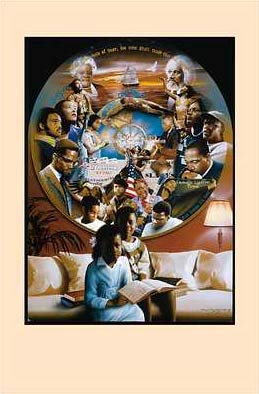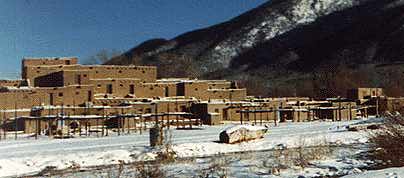 Before Columbus, before the "Americas," indigenous peoples organized in communities, nations and empires had resided in this hemisphere for over 40,000 years. According to recent scholarship, visitors from Africa, Asia and Europe arrived on these shores long before 1492. It was the Columbus voyage of 1492, however, that ushered in the era of European conquest, colonization and settlement in this hemisphere which led to the formation of the 49 nations that comprise North, South and Central America and the Caribbean.
Before Columbus, before the "Americas," indigenous peoples organized in communities, nations and empires had resided in this hemisphere for over 40,000 years. According to recent scholarship, visitors from Africa, Asia and Europe arrived on these shores long before 1492. It was the Columbus voyage of 1492, however, that ushered in the era of European conquest, colonization and settlement in this hemisphere which led to the formation of the 49 nations that comprise North, South and Central America and the Caribbean.
The African presence in the Americas is a direct consequences of the European - Spanish, Portuguese, Dutch, Danish, French and English - colonization of the "New World." Over the first 350 years of European occupation, more than 10 million Africans of many different ethnic groups were sold into slavery and distributed throughout the Americas. Modest estimates place their descendants at over 200 million. Over the past 500 years, Africans and their descendants have been involved at one level or another in virtually every aspect of the development of this hemisphere, providing the foundation on which today's Americas were built
It is estimated that upwards of 200 million people of African descent live in the 49 nations states in the Americas - North, Central and South America and the Caribbean. The African presence in the Americas, then, is at one and the same time biological and cultural, political and economic - an intriguing amalgam of conflicting social definitions of peoples believed to have some percentage of "black blood." Biologically, they are said to include those believed to be either of "pure African" blood or to have varying degrees of so-called African physical traits. Traditionally, in the United States, even a small fraction of "black blood" makes one black. In South and Central; America and Caribbean, the positive value given to "white blood" contributes toward making one whiter, or even white, depending on one's social status.
On the surface these racial ideologies appear to be very different; however, both are rooted in the same logic - perpetuation of whiteness as the pinnacle of a racial hierarchy.
Physical characteristics - skin color, hair texture and distinctive facial features - have been used to set blacks apart. Physical appearance has been transformed into
pseudoscientific claims
of differences in intellectual, physical and emotional capabilities, setting blacks at the bottom of a racial hierarchy. These presumed racial differences have been used to rationalize their exploitation and justify or explain their social position.
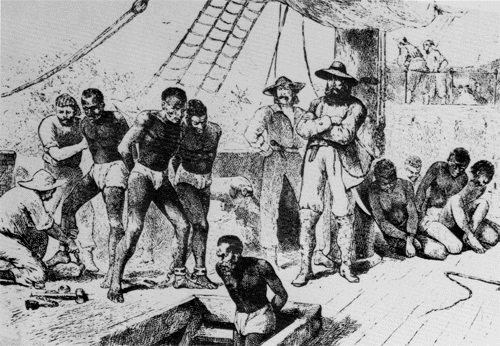 The voluntary and involuntary movement of people from one geographical area to another, has been central to the development of an African presence in North, Central, and South America and the Caribbean. The earliest African migrants were probably explorers who came voluntarily as early as 800 A.D.
The African Slave Trade to the Western Hemisphere has been very conservatively estimated at 10 million. Of this number, the United States received 399,000 slaves, the Caribbean 3.7 million slaves, and Brazil another 3.6 million.
Blacks were present for the very first European financed incursions into the continent. An African navigator sailed with Columbus' crew. The free Christianized African, Juan Garrido, was among the early conquerors of the island of Boriquen (today Puerto Rico), and also participated in the colonization of Mexico, where he was the first person to plant wheat in this hemisphere.
The voluntary and involuntary movement of people from one geographical area to another, has been central to the development of an African presence in North, Central, and South America and the Caribbean. The earliest African migrants were probably explorers who came voluntarily as early as 800 A.D.
The African Slave Trade to the Western Hemisphere has been very conservatively estimated at 10 million. Of this number, the United States received 399,000 slaves, the Caribbean 3.7 million slaves, and Brazil another 3.6 million.
Blacks were present for the very first European financed incursions into the continent. An African navigator sailed with Columbus' crew. The free Christianized African, Juan Garrido, was among the early conquerors of the island of Boriquen (today Puerto Rico), and also participated in the colonization of Mexico, where he was the first person to plant wheat in this hemisphere.
The genocide practiced against the indigenous peoples and the growing demand for labor resulted in the expansion of the slave trade.
There are countries to which we do not attribute an African past but in which the presence of Africans predates any significant presence of Africans in North America by over 100 years. During the 17th century, Buenos Aires, Argentina; Cartagena, Columbia; and Lima, Peru were major slave ports and points of distribution for Africans throughout South America. By 1537, there were already 338 slaves in Peru. In 1590, there were at least 20,000 blacks in Lima and Callao, Peru. A 17th-century census shows that in 1614, 40% of the population of Lima was black. Until the early 19th century, there was not one region of Brazil with a population of less than 50 % blacks. In fact, the earliest and largest transport of slaves was to South America which from 1451 to 1870 received in excess of 5 million slaves or 49% of the total
African Slave Trade
.
The end of the slave trade accelerated already existing patterns of voluntary internal migrations. In the Caribbean, newly emancipated African men and women moved from the countryside to the towns or to other islands, particularly British Guiana and Trinidad and Tobago, where they were recruited to work on sugar plantations. Between 1885 and 1930, Caribbean people migrated to Panama, Mexico, Columbia, Nicaragua, Honduras, Guatemala. Costa Rica, Curacao, Cuba and the United States. Eventually, racially restrictive immigration policies were enacted to limit the entry of Africans into Brazil, Argentina, Venezuela and the United States.
The volume of these migrations has rivaled that of the slave trade. In the United States, for example, six and a half million African-American people moved from the South to Northern and Western cities during the period from 1910 to 1970. These urban centers continue to receive blacks from the Caribbean and South America. In the United States as elsewhere, each wave of migration has brought changes in the demographic, cultural, economic and political life of the receiving society
Underlying the diversity among the peoples of African descent in the various countries of the Americas is a profound common link which is perhaps most evident in their expressive culture.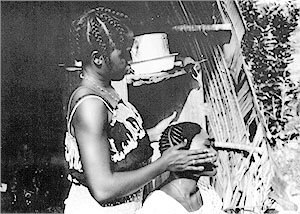
Confronted with alien environments and social structures that ran counter to their various ethnic and familial traditions, they used their traditional heritage to interpret and change their new world environments and social circumstances. These traditions continued to be the source of philosophical and aesthetic values. Africans maintained and/or adapted the elements of their African heritage to these conditions which enabled them to make sense of their lives. Dynamic cultures that are uniquely African-American have resulted from the interplay of these forces. They have left an indelible imprint on the Americas - defining the distinctiveness of African peoples here, while making a unique contribution to the definition of the Americas and Americans.
There is almost no popular American cultural form which has not been created, or at least influenced, by people of African ancestry. American music, dance, language, visual art, religion, festivals, cuisine and attitude are embedded with African elements. African cultural forms have given birth to jazz in the United States and the tango in Argentina; to Santeria in Cuba and Candomble in Uruguay; creole in Haiti and papiamento in Curacao; and carnivals from New Orleans and Jamaica to Brazil where the rhythms of merengue, calypso, samba, and guanguanco mix with the flavors of gumbo, feijoada, and rum. 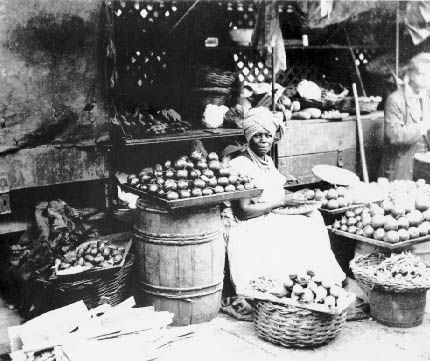
Of course, this African base was not simply transferred across the Atlantic. Various factors, not the least of which is the particular socio-economic position in which the majority of people of African descent have found themselves, have contributed to the formation of group identities and to the establishment of spaces for creation and struggle.
People of African descent have created and maintained families and communities, fraternities and sisterhoods, as well as unions, religious, social and political organizations. All have been instrumental in fostering both the individual and collective good and nurturing the continuing development of African-American cultural forms.
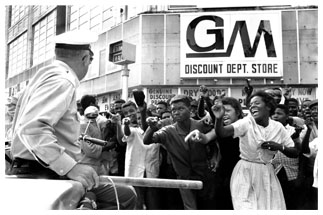
For the enslaved African, resistance began at the point of captivity. The very necessity of chains, shackles and whips was an acknowledgment by the slave traders of the fighting spirit of African men and women. Resistance to slavery and
racial oppression found various forms of expression
, but the central theme throughout the 500-year history of Africans in this hemisphere has been the struggle for
freedom, identity and dignity
.
In addition to individual acts of resistance, Africans and their descendants organized slave ship rebellions and established independent maroon communities such as Surinam's "Bush Negroes," Jamaica's Blue Mountain Maroons, St. Vincent's Bank Caribs, and the independent African state of Palmares in Brazil. Equally important in the history of slave resistance is the Underground Railroad in the United States. Revolution led to the establishment of Haiti, the first black republic in this hemisphere.
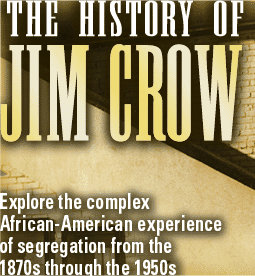 Just as Africans resisted enslavement, they continued to struggle for human and civil rights after slavery. Civil Rights and Black Power movements called international attention to Jim Crow, lynchings, colonialism and neocolonialism, racism and class oppression.
Just as Africans resisted enslavement, they continued to struggle for human and civil rights after slavery. Civil Rights and Black Power movements called international attention to Jim Crow, lynchings, colonialism and neocolonialism, racism and class oppression.

Historically, throughout the hemisphere, the involvement of blacks in military activity has been prompted not only by patriotism but also by the implicit or explicit promise of freedom and opportunity once the conflict was won. More frequently than not these promise were not met. Blacks in South America assumed an extremely active role in the 19-century wars of independence - so active a role that in the case of the Paraguayan war, the black population was virtually eliminated. In the United States, African-American servicemen waged "double victory" campaigns during every war from the War of Independence to the Vietnam War and the War in the Persian Gulf. While pursuing national war goals, they have had to simultaneously fight for freedom at home.
Throughout the hemisphere, consumer prices are rising, (real) wages are being driven downward, unemployment is escalating, working conditions are deteriorating, and trade unions and grassroots organizations are being subjected to heightened repression. Meanwhile, crime and violence are increasing, while social services and benefits are being drastically reduced. National economies struggle to pay off unpayable debts, while austerity measures impose the greatest hardship on the poor. Possessing few material resources and relying heavily on the family, community and social organizations as resources, African Americans continue to survive, persevere, and carry on the struggle for freedom and justice for all.

